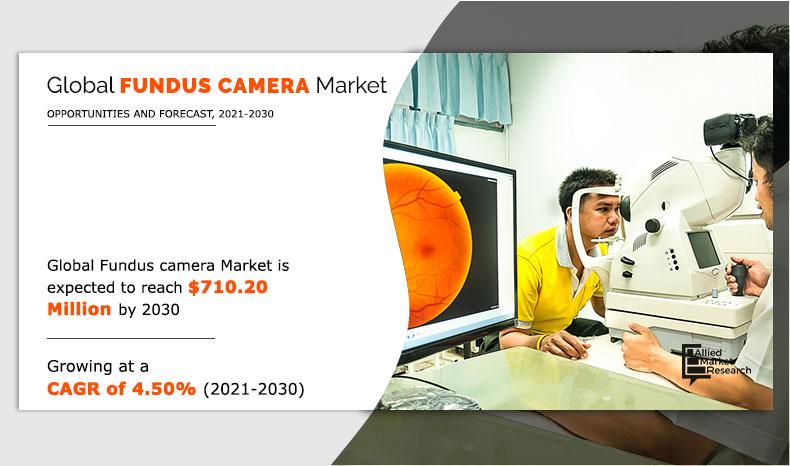Fundus Camera Market Size & Trends
The global fundus camera market size was valued at $445.60 million in 2020, and is estimated to reach $710.20 million by 2030, growing at a CAGR of 4.50% from 2021 to 2030. The fundus camera market expansion is driven by rise in number of cases of eye diseases such as diabetic retinopathy & glaucoma, an aging global population, and advancements in imaging technology. In addition, increasing awareness of routine eye exams and expanding healthcare access in emerging regions further drive demand, as early diagnosis of retinal conditions becomes more prioritized to improve patient outcomes. According to Center of Disease Control and Prevention, in 2021, an estimated 9.6 million people in the U.S. were living with diabetic retinopathy.
Key Takeaways
- By product type, the non-mydriatic cameras segment was the highest contributor to the market in 2020.
- By portability, the tabletop segment dominated the market in terms of revenue in 2020.
- By end user, the hospitals segment dominated the market in terms of revenue in 2020.
- By region, North America was the highest contributor to the market in 2020. However, Asia-Pacific is expected to register the highest CAGR during the forecast period.
A fundus camera captures detailed images of the retina, optic disc, macula, and posterior pole of the eye, aiding in diagnosing retinal diseases and monitoring ocular health. Equipped with high-resolution optics and imaging software, it is essential for detecting conditions like diabetic retinopathy, glaucoma, and macular degeneration, offering non-invasive, precise visualization for early intervention and treatment planning.
Market Dynamics
The growth of the fundus camera market is driven by several key factors, including a rise in geriatric population, development of healthcare infrastructure, and growing prevalence of ophthalmic diseases.
The rise in the geriatric population is a key factor driving growth in the fundus camera market. According to the United Nations, the number of people aged 65 years or older worldwide is projected to more than double, rising from 761 million in 2021 to 1.6 billion in 2050. As people age, their susceptibility to these conditions increases, necessitating regular eye examinations and diagnostics to prevent or manage potential vision loss. Fundus cameras, which capture detailed images of the retina, are vital tools in early detection and treatment planning for these age-related diseases. Furthermore, advancements in healthcare and prolonged life expectancy contribute to a growing elderly population globally, expanding the need for specialized ophthalmic care.
The development of healthcare infrastructure plays a crucial role in driving the fundus camera market by creating better access to advanced ophthalmic diagnostic tools. According to International Trade Administration, the Indian healthcare industry reached over $370 billion in 2022 and is expected to reach over $610 billion by 2026. With expanding healthcare facilities, especially in emerging economies, there is an increased demand for advanced diagnostic equipment to meet the needs of a growing patient population. This expansion includes the establishment of specialized eye care centers, improved hospital facilities, and government-funded healthcare projects, all of which require comprehensive ophthalmic diagnostic tools. Fundus cameras, which are essential for detecting and monitoring retinal diseases, become integral in these setups as healthcare systems aim to improve early detection and management of ocular conditions. Centers for Disease Control and Prevention (U.S.) announced the funding of $6.5 million for vision and eye health programs in 2023. Funding initiatives to modernize healthcare infrastructure often prioritize digital and high-resolution imaging equipment, further boosting the demand for technologically advanced fundus cameras that can support efficient and accurate diagnoses. Thus, the developing healthcare infrastructure is expected to drive the growth of the market.
Furthermore, the rise in prevalence of retinal disorders, such as diabetic retinopathy, age-related macular degeneration (AMD), and glaucoma, is a significant driver for the fundus camera market. According to a 2022 article by Glaucoma Research Foundation, there were around 80 million glaucoma patients worldwide. Furthermore, according to Centers for Disease Control and Prevention, in 2021 across all ages, an estimated 9.6 million people in the U.S. were living with diabetic retinopathy. With diabetes rates climbing globally, diabetic retinopathy, a complication affecting the retina's blood vessels, has become increasingly common, necessitating more frequent and specialized imaging. These conditions demand regular monitoring, which fundus cameras can provide by capturing high-resolution images of the retina to track disease progression and guide treatment. In addition, advancements in imaging technology, such as non-mydriatic and ultra-widefield fundus cameras, enhance the accessibility and precision of retinal imaging, further supporting the market growth.
In addition, technological advancements are significantly driving the growth of the fundus camera market, enhancing both the quality and functionality of these devices. Innovations in digital imaging have enabled high-resolution imaging, which provides detailed views of the retina and supports accurate diagnosis of various ocular diseases. Integration of artificial intelligence (AI) and machine learning (ML) in fundus cameras has facilitated automated image analysis, allowing for early detection of conditions like diabetic retinopathy and glaucoma. In addition, advancements in optical coherence tomography (OCT) have allowed fundus cameras to capture three-dimensional images, which offer a more comprehensive view of retinal layers and support in-depth assessment of retinal health. The shift toward handheld and portable fundus cameras has also improved accessibility, particularly in remote areas where traditional equipment may be difficult to use. Wireless connectivity and cloud storage options further enhance data management, enabling seamless sharing and remote consultations. These innovations collectively improve diagnostic accuracy, streamline workflow in clinical settings, and broaden the reach of retinal care, fueling the demand and growth of the fundus camera market.
However, a key restraint in the fundus camera market is the high cost of advanced fundus cameras, and lack of skilled technicians. High-resolution and automated fundus cameras, essential in modern ophthalmic diagnostics, are often costly, limiting adoption in smaller clinics or regions with budget constraints. In addition, operating fundus cameras, especially advanced models, requires trained professionals, and a shortage of these can hinder market expansion, particularly in developing regions.
Segments Overview
The fundus camera market is segmented into product type, portability, end user, and region. By product type, the market is categorized into mydriatic fundus cameras, non-mydriatic fundus cameras, hybrid fundus cameras, and ROP fundus cameras. By portability, it is fragmented into handheld fundus cameras, and tabletop fundus cameras. By end user, it is segregated into hospitals, ophthalmology clinics, and others.
Region-wise, the fundus camera market is analyzed across North America (the U.S., Canada, and Mexico), Europe (Germany, France, the UK, Italy, Spain, and rest of Europe), Asia-Pacific (Japan, China, India, Australia, and rest of Asia-Pacific), and LAMEA (Brazil, South Africa, Saudi Arabia, and rest of LAMEA).
By Product Type
On the basis of product type, the non-mydriatic cameras segment was the major revenue contributor in 2020 and is anticipated to remain dominant during the forecast period. This is attributed to the ability of a non-mydriatic camera to view detailed retinal anatomy and, thereby, improve the diagnosis and management of eye disorders. In addition, non-mydriatic cameras advancements such as fluorescein imaging, mobility, and live-action systems are expected to drive the market throughout the forecast years.
By Portability
On the basis of portability, the tabletop segment dominated the fundus camera market in 2020 and is anticipated to continue this trend during the forecast period. This is attributed to the advantages of these cameras as they offer more patient-friendly photography of the fundus by eliminating the use of bright lights and dilating drops.
By End User
Based on end user, the hospitals segment dominated the market terms of revenue in 2020 owing to increasing integration of advanced diagnostic tools within hospital facilities and the rising prevalence of eye disorders. Hospitals often have a higher patient volume, especially in ophthalmology departments, where fundus cameras are essential for diagnosing and managing conditions like diabetic retinopathy, glaucoma, and age-related macular degeneration. These facilities also benefit from a larger infrastructure and budget, enabling the acquisition of high-quality imaging equipment to improve patient outcomes.
By Region
Region wise, North America was the largest shareholder in the global fundus camera market in 2020. Diabetes has become much more prevalent in North America during the last decade and diabetic patients are at a much higher risk for diabetic retinopathy than non-diabetics. Moreover, the rise in geriatric population, increased healthcare expenditure, and government support for reimbursement and device screening is also responsible for the growth of the market in this region. On the other hand, Asia-Pacific is expected to witness growth at the fastest rate during the forecast period, due to the local presence of key players, availability of expert services, and growing medical tourism. Increased awareness in the region about retinal and ocular illnesses as well as rising awareness about treating diabetic retinopathy, is also driving the fundus cameras market.
Competitive Analysis
Major key players that operate in the global fundus camera market are Carl Zeiss Meditec AG, Kowa Company, Ltd., Optomed Plc, Optovue Incorporated, Topcon Corporation, Clarity Medical Systems, Inc., Canon Inc., Epipole Ltd, Revenio Group Corporation (Centervue SPA), and Clarity Medical Systems, Inc. Key players have adopted product launch as key developmental strategies to improve the product portfolio of the fundus camera market.
Recent Developments in the Fundus Camera Industry
- In May 2024, Optomed USA, Inc. announced the launch of the Optomed Aurora AEYE, a portable AI fundus camera that detects more than mild diabetic retinopathy. It allows diabetic patients in primary care to receive on-the-spot eye examinations and rapid retinopathy identification before being directed to an eye care expert.
- In March 2022, Epipole announced the global launch of its new epiCam fundus camera in the U.S. eye care industry. The epiCam is a powerful, ultra-portable wireless fundus camera that uses epipole's video direct ophthalmoscopy (VDO) platform to capture live, high-resolution video footage of the live retina as well as accompanying still photos.
Key Benefits for Stakeholders
- This report provides a quantitative analysis of the market segments, current trends, estimations, and dynamics of the Fundus Camera market analysis from 2023 to 2032 to identify the prevailing Fundus Camera market opportunities.
- Market research is offered along with information related to key drivers, restraints, and opportunities.
- Porter's five forces analysis highlights the potency of buyers and suppliers to enable stakeholders to make profit-oriented business decisions and strengthen their supplier-buyer network.
- In-depth analysis of the Fundus Camera market segmentation assists to determine the prevailing market opportunities.
- Major countries in each region are mapped according to their revenue contribution to the global Fundus Camera market.
- Market player positioning facilitates benchmarking and provides a clear understanding of the present position of the market players.
- The report includes the analysis of the regional and global Fundus Camera market trends, key players, market segments, application areas, and market growth strategies.
Analyst Review
According to perspective of CXOs of the leading companies, the global fundus camera market gained prominence in 2020, and is expected to witness a significant rise in the near future. This is attributed the rise in incidence of retinal problems due to rise in elderly population and chronic diseases such as diabetes and hypertension. Diabetic Retinopathy (DR), Age-related Macular Degeneration (AMD), and Retinopathy of Prematurity (ROP) are some of the most common retinal diseases. In addition, rising awareness about eye disorders and the introduction of a number of technologically improved goods are expected to move the market forward throughout the forecast period. These are the factors that reinforce the growth of the market. However, high cost associated with the fundus camera is expected to hamper the market growth.
Many significant key players across the globe are planning to expand their production capacities and delivery services in order to meet the rising demand due to the pandemic, which is expected to offer high growth opportunities to the key players.
Advancements in digital camera, red-free fundus camera, film-based fundus camera to the development of other for clear and in-depth fundus imaging as well as the growing adoption of these new technologies in emerging countries, which are expected to drive demand for these products during the forecast period. Furthermore, market expansion is projected to be aided by favorable government policies.
The total market value of fundus camera market is $445.60 million in 2020.
The forcast period for fundus camera market is 2021 to 2030
The market value of fundus camera market in 2030 is $710.20 million.
The base year is 2020 in fundus camera market
Top companies such as Canon, Inc., Topcon Medical, Systems, Inc., NIDEK Co., Ltd., CenterVue SpA, Carl Zeiss Meditec, Inc. held a high market position in 2020. These key players held a high market postion owing to the strong geographical foothold in different regions.
By product,non-mydriatic cameras segment is the most influencing segment. This is attributed to the ability of a non-mydriatic cameras to view detailed retinal anatomy and, thereby, improves the diagnosis and management of eye disorders. In addition, non-mydriatic cameras advancements such as fluorescein imaging, mobility, and live-action systems are expected to drive the market throughout the forecasted years.
The major factor that fuels the growth of the global fundus camera market includes Increasing prevalence of chronic eye diseases, supportive government regulations, and increasing strategic alliances and awareness regarding retinal disorder drive the growth of the global fundus camera market. However, high costs of fundus camera and lack of awareness, low access to eye care in low-income economies is expected to hamper the market growth.
Asia-Pacific is expected to grow at the fastest rate in the forecasted years due to local presence of key players, availability of expert services, and growing medical tourism. Increased awareness in the region about retinal and ocular illnesses, as well as rising awareness about treating diabetic retinopathy, is also driving the fundus cameras market
Fundus camera is used to diagnose various types of retinal disorders such as glaucoma, diabetic retinopathy, retinal detachment, and age-related macular degeneration
mydriatic fundus cameras, non-mydriatic fundus cameras, hybrid fundus cameras, and rop fundus cameras
Loading Table Of Content...




